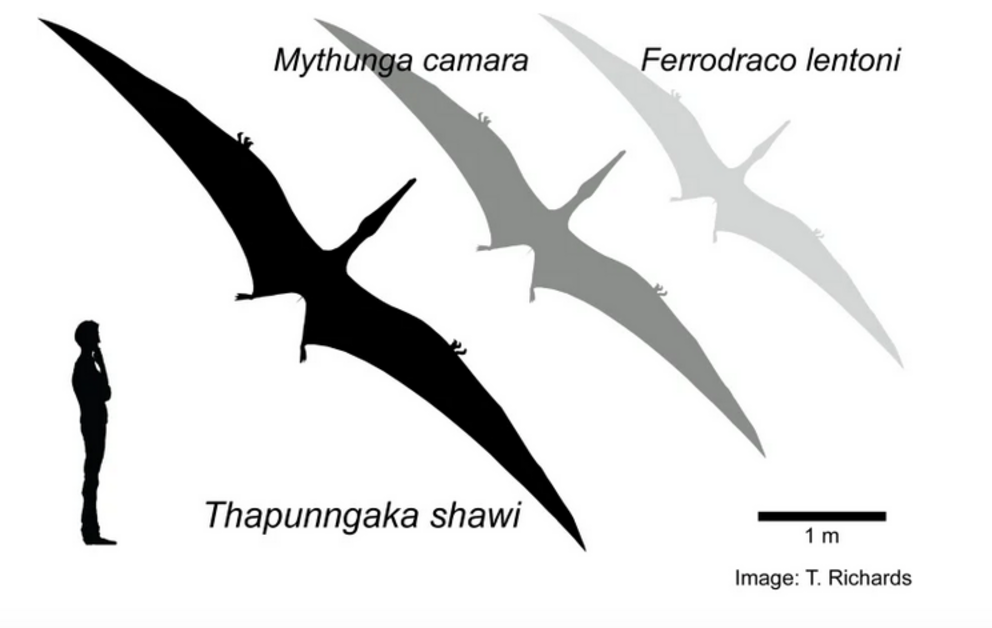A terrifying 'dragon' was the largest known flying reptile of ancient Australia
With a seven-meter wingspan, and a mouth bristling with fangs, a newly discovered pterosaur would have ruled the skies over Australia's northeast around 110 million years ago.
It's the largest species of pterosaur ever found on the continent, an extremely important find that contributes to our understanding of pterosaur diversity in Australia. And it would have been absolutely metal.
"It's the closest thing we have to a real life dragon," said paleontologist Tim Richards of the University of Queensland in Australia.
"The new pterosaur, which we named Thapunngaka shawi, would have been a fearsome beast, with a spear-like mouth and a wingspan around seven meters (23 feet). It was essentially just a skull with a long neck, bolted on a pair of long wings.
"This thing would have been quite savage. It would have cast a great shadow over some quivering little dinosaur that wouldn't have heard it until it was too late."

Hypothetical outline of Thapunngaka shawi. (Tim Richards)
Pterosaur remains in Australia are extremely rare. Like today's birds, their bones - optimized for flight - were hollow and brittle, and thus very few have survived to the present day. Fewer than 20 specimens have been described from the continent, and only three, prior to T. shawi, had been named.
Also, only two Australian pterosaurs belonged to a group known as the anhanguerian pterosaurs, both hailing from the northeastern state of Queensland. T. shawi marks the third anhanguerian hailing from Australia; it's also from Queensland.
Its description is based on a fragment of lower jaw, and what we know of other anhanguerian pterosaurs. It was named for the fossicker who discovered it, Len Shaw, and incorporates words from the language of the First Nations people who inhabited the region, the Wanamara Nation.
"The genus name, Thapunngaka, incorporates thapun [ta-boon] and ngaka [nga-ga], the Wanamara words for 'spear' and 'mouth', respectively," said paleontologist Steve Salisbury of the University of Queensland.

Reconstruction of the skull of T. shawi. (Tim Richards)
According to the team's reconstruction, T. shawi's skull would have been around a meter long (3.3 feet), with around 40 teeth. The beast would have flown above the inland Eromanga Sea that once dominated eastern Australia, using its long, powerful jaw to pluck fish from the water.
Of particular interest, the researchers found, was a large bony crest on the bottom of the jaw. Based on what we know of anhanguerians, the animal's top jaw also sported such a crest.
"These crests probably played a role in the flight dynamics of these creatures, and hopefully future research will deliver more definitive answers," Salisbury said.
It's from this crest that the researchers estimated the pterosaur's size - it is, they said, the largest mandibular crest known from any anhanguerian. If their estimations are correct, T. shawi would be the third largest anhanguerian pterosaur known worldwide.
This suggests that Australian pterosaurs rivaled contemporaneous species from other continents in terms of size. In addition, the anatomical similarities between the jawbone of T. shawi and those of other Australian pterosaurs suggest there may have been a local pterosaur species diversification around the Eromanga sea.
"It's quite amazing fossils of these animals exist at all," Richards said.
"By world standards, the Australian pterosaur record is poor, but the discovery of Thapunngaka contributes greatly to our understanding of Australian pterosaur diversity."
The research has been published in the Journal of Vertebrate Paleontology.

